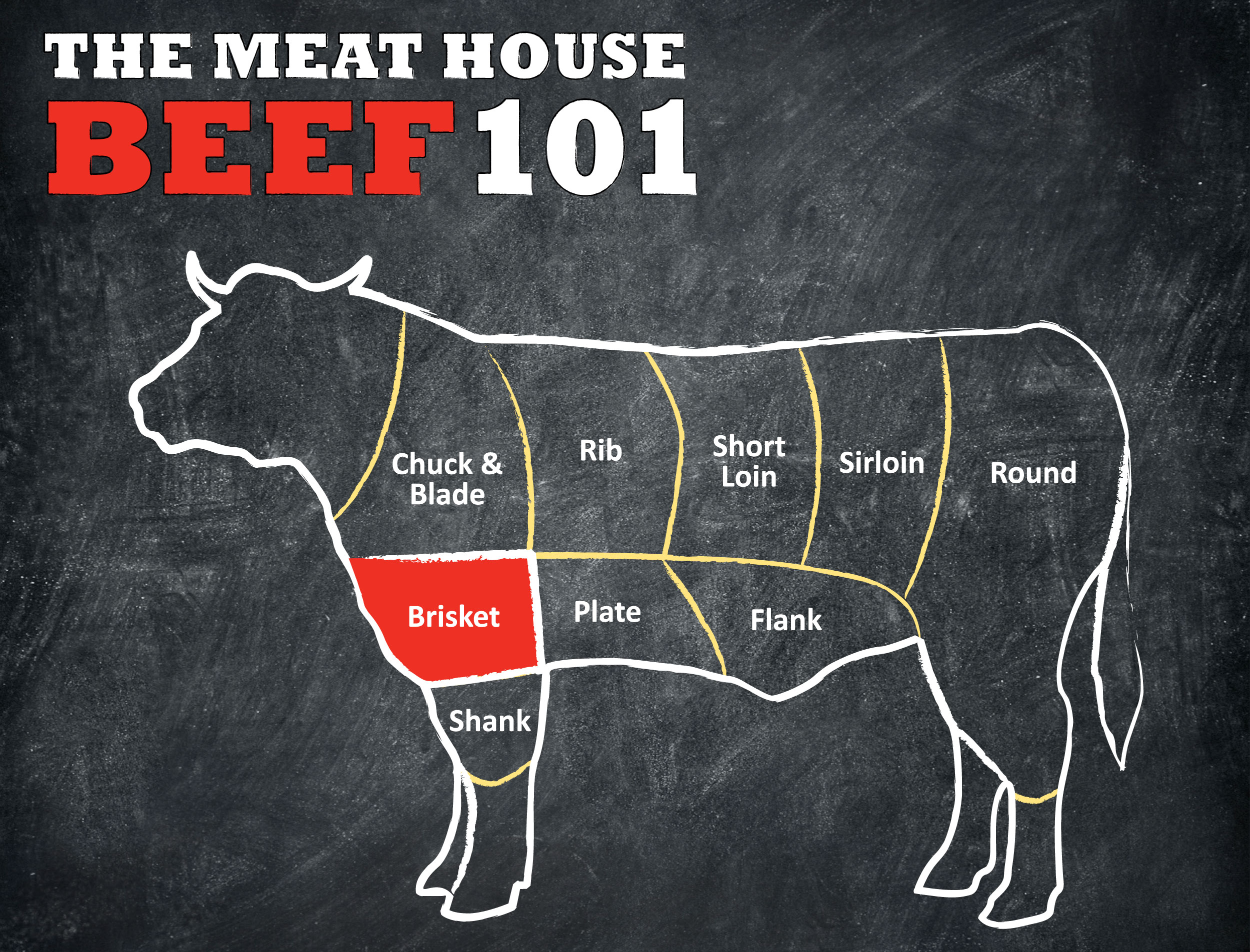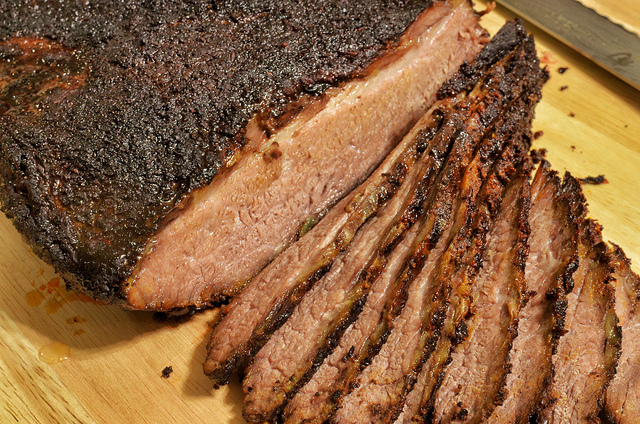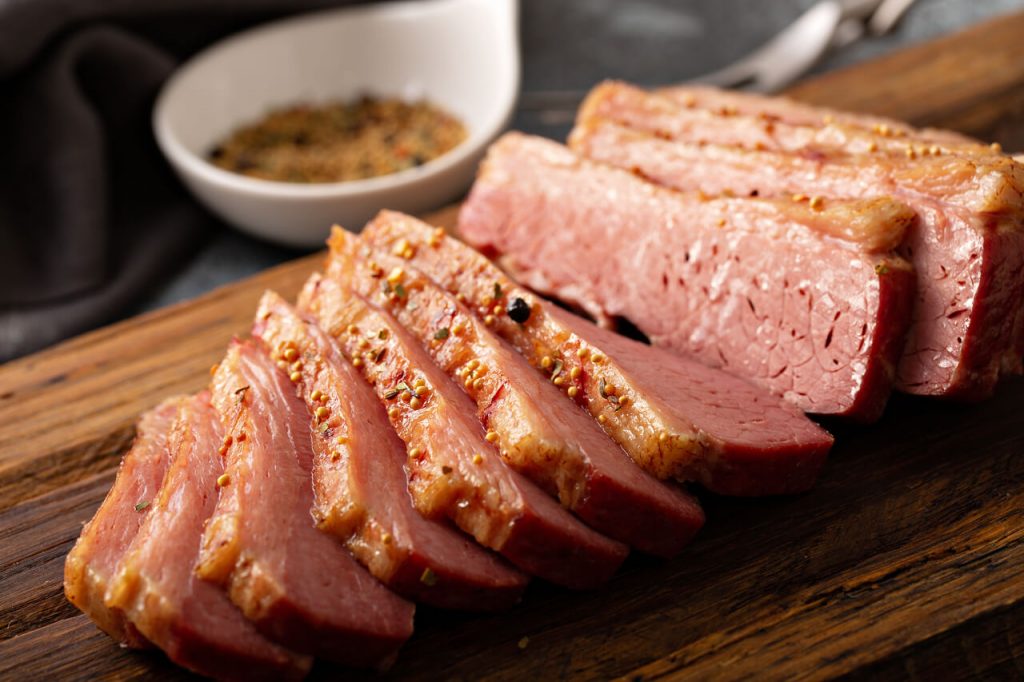Corned Beef Vs Beef Brisket: Understanding Beef Cuts

In understanding the differences between corned beef and beef brisket, it is important to emphasize that they are not interchangeable cuts of beef. While both come from the chest area of the cow, the preparation and cooking methods vary significantly, resulting in distinct taste and texture profiles. Corned beef is a cured and salted cut of beef, typically associated with St. Patrick’s Day and commonly used in deli sandwiches. On the other hand, beef brisket, known for its rich flavor and tenderness, is often smoked or slow-cooked to perfection. So, when choosing between corned beef and beef brisket, it is crucial to consider the desired flavor and cooking technique for your recipe.
Differentiating Corned Beef And Beef Brisket
Corned beef and beef brisket are two distinct cuts of beef, each with its own unique characteristics. Here are the key differences between the two:
- Preparation: Corned beef is cured and salted, giving it a tangy and salty flavor. Beef brisket, on the other hand, is not cured and has a more natural beefy flavor.
- Cooking methods: Corned beef is typically boiled or simmered to achieve a tender and flavorful result. Beef brisket is often smoked or slow-cooked, resulting in a tender and juicy texture.
- Texture: Corned beef is softer and more tender, while beef brisket has a slightly firmer texture.
Overall, corned beef is known for its tangy and salty taste, while beef brisket is prized for its rich and beefy flavor. When selecting between the two, consider the desired flavor profile and cooking method for your recipe.
Popular Uses For Corned Beef And Beef Brisket
Corned beef has become synonymous with traditional St. Patrick’s Day meals. It is often used to make classic dishes like corned beef and cabbage, Reuben sandwiches, and corned beef hash. Its tangy and salty flavor pairs well with hearty vegetables and spices.
Beef brisket is a versatile cut that is popular in various cuisines. It is commonly used to make barbecue brisket, a slow-cooked and smoky dish that is beloved in the southern United States. It can also be roasted or braised and served as a main dish, sliced thin for sandwiches, or even used as an ingredient in chili or stews.
Corned Beef

Corned Beef is a popular type of meat that is often associated with St. Patrick’s Day and Irish cuisine. It is made from brisket, which is a cut of beef from the breast or lower chest of a cow. The brisket is cured in a brine solution of water and salt for several days, giving it its distinctive salty flavor. Corned beef is known for its tender texture and rich, savory taste. It is commonly used to make classic dishes like corned beef and cabbage, Reuben sandwiches, and corned beef hash.
Corned Beef: What It Is And How It’s Made
Corned beef is a type of meat that is made from brisket, a cut of beef from the breast or lower chest of a cow. It gets its name from the curing process, where the beef is soaked in a brine solution of water and salt for several days. Other seasonings such as peppercorns and spices are often added to enhance the flavor. This brining process gives the corned beef its distinctive salty taste and tender texture. Once cured, the corned beef can be cooked by boiling, braising, or slow cooking methods.
Cooking Methods For Corned Beef
Cooking methods for Corned Beef can vary depending on personal preference and desired tenderness. Here are some popular cooking methods for corned beef:
- Boiling: Place the corned beef in a large pot and cover it with water. Add spices and seasonings, then bring it to a boil. Reduce heat and simmer for a few hours until the meat is tender.
- Braising: Brown the corned beef in a pan, then transfer it to a roasting pan. Add vegetables, such as cabbage and carrots, along with broth or beer. Cover and cook in the oven at a low temperature for several hours.
- Slow-cooking: Place the corned beef in a slow cooker with spices and liquids, such as broth or beer. Cook on low heat for 8-10 hours until the meat is tender.
- Oven-roasting: Preheat the oven and place the corned beef in a roasting pan. Add vegetables and liquids, then cover and cook at a low temperature for several hours.
Remember to slice the corned beef against the grain for maximum tenderness.
Beef Brisket

Beef Brisket, a cut of meat taken from the breast section of the cow, is known for its rich flavor and tenderness when cooked properly. It is a tough cut of meat with layers of fat and connective tissue, but with slow cooking techniques, it becomes incredibly tender and juicy. Beef Brisket is commonly used in barbecue, slow-cooked dishes, and traditional Jewish cuisine. It is usually sold as a whole cut, with the option to trim the fat cap based on personal preference. Proper preparation and cooking techniques are essential to ensure a flavorful and moist beef brisket.
Beef Brisket: Overview Of The Cut And Variations
Beef brisket is a cut of meat taken from the breast section of the cow. It is renowned for its rich flavor and tenderness when cooked properly. This cut is known for its layers of fat and connective tissue, which add to its flavor and moistness. Beef brisket is commonly used in barbecue and slow-cooked dishes. There are different variations of beef brisket, including whole cut and trimmed fat cap options. The proper preparation and cooking techniques are essential to ensure a flavorful and tender beef brisket.
Best Practices For Preparing And Cooking Beef Brisket
When preparing and cooking beef brisket, there are a few best practices to keep in mind. Here are some key tips:
- Choose the right cut: Look for a brisket with a good amount of marbling and a thick fat cap for maximum flavor and tenderness.
- Trim excess fat: Trimming some of the excess fat can help prevent the meat from becoming too greasy during cooking.
- Season properly: Rub the brisket with a flavorful dry rub or marinade to enhance its taste. Allow it to marinate for a few hours or overnight for optimal flavor.
- Cook low and slow: Beef brisket is best cooked at a low temperature for a long period of time. This slow cooking method helps break down the tough connective tissue and results in a tender and juicy brisket.
- Use indirect heat: Whether you’re using a smoker, grill, or oven, make sure to cook the brisket using indirect heat to ensure even cooking and a smoky flavor.
- Wrap in foil or butcher paper: To help retain moisture and tenderness, wrap the brisket in foil or butcher paper during the cooking process. This helps create a barrier and traps in the juices.
- Let it rest: After cooking, allow the brisket to rest for at least 30 minutes before slicing. This allows the juices to redistribute, resulting in a more flavorful and moist brisket.
By following these best practices, you can ensure that your beef brisket is cooked to perfection and will be a crowd-pleasing dish.
Nutritional Comparison

When it comes to the nutritional value of corned beef and beef brisket, there are some key differences to consider. Corned beef is generally higher in sodium content due to the curing process, while beef brisket is lower in sodium but higher in protein. In terms of fat content, both cuts can vary depending on the amount of marbling present. Overall, beef brisket tends to be a leaner option compared to corned beef. It’s important to note that the nutritional content can vary depending on the cooking methods and ingredients used.
Nutritional Content Of Corned Beef
Corned beef is a flavorful and savory meat option that is often enjoyed as part of a hearty meal. When it comes to its nutritional content, corned beef is relatively high in calories and fat. A 3-ounce serving of corned beef contains approximately 210 calories and 8 grams of fat, with around 3 grams of saturated fat. It is also a good source of protein, providing about 17 grams per serving. It is important to note that the sodium content in corned beef can be quite high due to the curing process, with around 800-1200 milligrams per serving.
Nutritional Content Of Beef Brisket
Beef brisket is a flavorful and rich cut of meat that is often enjoyed in various dishes. In terms of its nutritional content, beef brisket is relatively high in calories and fat. A 3-ounce serving of beef brisket contains approximately 248 calories and 17 grams of fat, with around 6 grams of saturated fat. It is also a good source of protein, providing about 23 grams per serving. However, it is important to note that beef brisket can be high in sodium, with around 650-950 milligrams per serving.
Flavor Profiles

The flavor profiles of corned beef and beef brisket differ significantly. Corned beef has a distinct salty and tangy flavor due to its curing process in a brine solution. It also has a slightly sweet and savory taste that pairs well with traditional accompaniments like cabbage and potatoes. On the other hand, beef brisket has a rich, beefy flavor with a pronounced smokiness when cooked using barbecue or smoking methods. It has a tender and juicy texture, making it a favorite for slow cooking and deliciously seasoned rubs. The flavor profiles of both cuts offer unique and satisfying culinary experiences.
Flavor Profile Of Corned Beef
Corned beef has a distinct flavor profile that is salty, tangy, and slightly sweet. The brining process infuses the meat with a rich and savory taste that is enhanced by the spices used in the brine, such as coriander, mustard seeds, and cloves. The curing process also adds a depth of flavor to the beef, resulting in a unique and appetizing combination of flavors. This makes corned beef a perfect choice for traditional dishes like corned beef and cabbage, where the flavors of the beef are complemented by the sweetness of the cabbage and the creaminess of the potatoes.
Flavor Profile Of Beef Brisket
Beef brisket has a rich and intense flavor profile that is deeply savory and beefy. The slow cooking process allows the natural fat and collagen in the meat to melt, resulting in a tender and juicy texture. The smoky and caramelized exterior, achieved through smoking or roasting, adds a depth of flavor. The spices and seasonings used in the rub or marinade further enhance the taste, creating a delicious blend of smokiness, sweetness, and spices. The flavor of beef brisket can vary depending on the cooking method and added ingredients, making it a versatile and flavorful cut of meat.
Conclusion

In conclusion, understanding the differences between corned beef and beef brisket is essential in choosing the right cut for your culinary needs. Corned beef, with its salty and tangy flavor, is commonly associated with Irish cuisine and is often enjoyed during St. Patrick’s Day celebrations. On the other hand, beef brisket offers a rich and intense flavor profile, perfect for slow cooking methods like smoking or roasting. Consider the desired taste and cooking method when deciding between these two cuts of meat. Whether you’re craving a classic corned beef dish or a tender and juicy beef brisket, both options offer delicious possibilities for your culinary creations.
Summarizing The Key Differences Between Corned Beef And Beef Brisket
Corned beef and beef brisket may have some similarities, but they are prepared and cooked differently, resulting in distinct tastes and textures. Corned beef is beef brisket that has been brine-cured, giving it a salty and tangy flavor. On the other hand, beef brisket is a big roast with a rich and intense flavor profile. Additionally, corned beef is often associated with St. Patrick’s Day and Irish cuisine, while beef brisket is a versatile cut used in various cooking methods. Both cuts offer unique culinary possibilities based on your desired taste and cooking style.
Tips For Choosing The Right Cut For Your Dishes
When it comes to choosing the right cut of meat for your dishes, there are a few factors to consider. First, determine your cooking method. If you’re planning to slow cook or braise the meat, beef brisket is an excellent choice due to its high fat content and rich flavor. On the other hand, if you’re looking for a tender and juicy cut for quick cooking methods like grilling or pan-searing, go for a leaner cut like corned beef. Additionally, consider the desired flavor profile and texture to select the perfect cut for your dishes.
FAQ About Corned Beef Vs Beef Brisket: Understanding Beef Cuts
Q: What is the main difference between corned beef and beef brisket?
A: The main difference lies in the preparation method. Corned beef is beef brisket that has been cured in a seasoned brine, while beef brisket refers to the cut of meat itself.
Q: How do the flavors of corned beef and beef brisket differ?
A: Corned beef has a salty and tangy flavor due to the curing process, whereas beef brisket has a more natural beefy and rich flavor.
Q: Can corned beef be made from cuts other than brisket?
A: Yes, while traditionally corned beef is made from brisket, it can also be made from cuts like round or rump.
Q: Which cut is better for slow cooking – corned beef or beef brisket?
A: Both cuts are great for slow cooking, but beef brisket is often preferred as it tends to be more tender and flavorful when cooked low and slow.
Q: How should one store corned beef and beef brisket?
A: Both corned beef and beef brisket should be stored in the refrigerator wrapped tightly in plastic or aluminum foil to maintain freshness.

Hot Pot Chinese Restaurant, located in Mechanicsville, MD 20659, is a culinary destination that offers a delightful array of Chinese cuisine. From the cozy ambiance to the delectable dishes, Hot Pot Chinese Restaurant is dedicated to providing an exceptional dining experience for all patrons. Since our establishment, Hot Pot Chinese Restaurant has been committed to serving the finest Chinese food, offering a diverse menu that caters to a wide range of tastes. Whether you’re craving traditional favorites like Kung Pao Chicken and Mongolian Beef or seeking out more adventurous options like Szechuan Spicy Hot Pot, our menu has something to satisfy every craving.